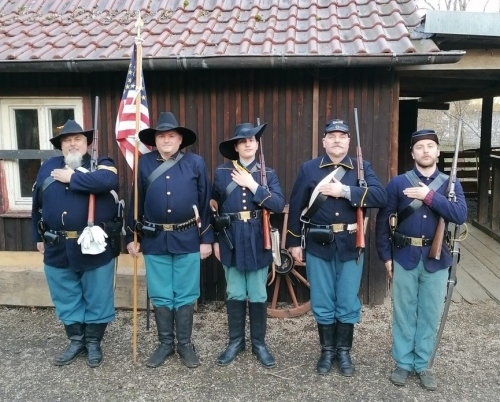Unsere Truppe
2023 hat es sich so ergeben das bei einem Ranchabend auf einmal fünf Gleichgesinnte da waren in der Uniformierung der US Kavallerie des Zeitraumes um 1872 bis 1877. So eintstand die Idee eine eigene Truppe zu gründen.
Eine Vielzahl der US Soldaten in den Plains waren Auswanderer aus Deutschland, Irland und auch der Schweiz. Ein gutes Beispiel dafür ist Christian Barthelmess der als junger Mann von Bayern aus in nach Amerika auswanderte und dort 1876 zur US Kavallerie ging. Er war ein Hobbyfotograf und hielt mit seiner Kamera sein Leben als Soldat im Westen und das Leben der Indianer zu dieser Zeit fest. (Das Buch dazu: Photographer on an Army Mule)
Unster Ziel ist die Darstellung des Soldatenlebens während der Zeit der sogenannten "Plains Indian Wars" wie sie in den USA genannt wird. Wir stehen dabai auch im Austausch mit Darstellern und Gruppen der Ureinwohner in Kontakt.
Hier ein paar Eindrücke der Zusammenkünfte
Rekrutierung
wir haben hier einen kleinen Leitfaden für die Ausstattung eines Troopers der US Kavallerie um 1874/76 erstellt. Keine Garantie auf vollständigkeit da es noch unzählige Varianten und Versuchsmodelle gab.
Ausstattung M1874-76 und Reenactment Reg[...]
PDF-Dokument [3.7 MB]
Folgenden Text fand eines unserer Mitglieder und Zeigt quasi die Inventur eines Cheyenne Dorfes:
Have you ever wondered what was in a typical Tipi village of the Indian Wars era?
On April 18th 1867, General W. Hancock burned a combined Sioux-Cheyenne Village on the Pawnee Fork river in Kansas. Lt. Col. George Custer was ordered to surround the abandoned village, but it was Hancock’s decision to burn the village. Hancock determined to destroy the village, except for 40 lodges that were retained and to be given to the newly recruited Indian Scouts. Scouts Ed Guerrier, Bill Comstock and Delaware Indian scouts assisted. Everything else was inventoried, piled together, and burned. Lieutenant Colonel J.W. Davidson, 10th Cavalry under Hancock’s command, made a list of the items a
Items from the Cheyenne Village
Lodges 111
Bridles 11
Buffalo Robes 522
Curry-combs 11
Traventers (travois?) 238
Blacksmith Tongs 1
Parfleches 144
Lariats 164
Whet-stones 8
Coffee-mills 13
Rubbing bones 9
Rawhide ropes 48
Water kegs 35
Sacks paint 142
Saddles 197
Oven 1
Hoes 22
Hammers 6
Head-mats 142
Stew-pans 4
Axes 49
Spades 5
Crow-bars 12
Pitchforks 5
Fleshing-irons 39
Knives 9
Brass kettles 19
Pick-axe 6
Coffee-pots 8
Wooden spoons 14
Tin cups 134
Meat-stones 22
Fry-pans 34
Files 8
Skillets 1
Scythes 4
Horn spoons 55
Meat-skewers 7
Chairs 78
Kettles 49
Drawing-knives 4
Tea-kettles 12
Inventory of Articles in the Sioux Camp:
Lodges 140
Hoes 34
Buffalo robes 420
Head-mats 145
Traventers (travois) 197
Axes 142
Parfleches 159
Crowbars 15
Whet-stones 2
Fleshing-irons 42
Rubbing-bones 2
Brass kettles 54
Water-kegs 63
Coffee-pots 59
Saddles 239
Tin pans 179
Iron spoons 25
Spades 2
Tin cups 216
Pitch-forks 3
Fry-pans 43
Knives 3
Horn spoons 94
Pick-axes 6
Chairs 51
Wooden spoons 4
Drawing-knives 9
Door-mats 140
Bridles 9
Stone mallets 61
Curry-combs 4
Swords 1
Lariats 280
Bayonets 1
Coffee-mill 15
U.S. mail-bags 1
Sacks paint 70
Lances 1
Ovens 5
Kettles 141
Hammers 11
Tea-kettles 3
Stew-pans 4
Remarks- Six (6) ponies were also found running loose near the villages.
(signed) J.W. DAVIDSON Lieutenant Colonel, 10th Cavalry Brevet Major General, Acting Inspector General A true copy: W.G. MITCHELL, Captain and A.A.A.G
Another list of goods came from a Cheyenne village captured July 11th, 1869, at Susanna Springs (Summit Springs).
This was the last big fight of the Cheyenne Dog Men society, and the last time a Dog Rope wearer deployed or used his Dog Rope in battle.
When the 5th United States Cavalry, commanded by General Eugene A. Carr, left the village site, there were 160 separate fires burning an estimated ten tons of items.
Some items were carried off as souvenirs by some of the soldiers, but the itemized list contained the following:
56 Rifles
22 Revolvers
40 Sets of bows and arrows
20 Tomahawks
47 Axes
150 Knives
50 Pounds powder
20 Pounds bullets
14 Bullet molds
8 Bars lead
25 Boxes percussion caps
17 Sabers
17 War Shields
9 Lances
13 War Bonnets
690 Buffalo robes
552 Panniers (Parfleches)
152 Moccasins
319 Raw hides
361 Saddles
31 Mess pans
52 Water kegs
67 Brass & iron camp kettles
200 Rawhide lariats
16 Bottles strychnine
84 Lodges, complete
125 Travois
9300 Pounds meat, dried
160 Tin cups
180 Tin plates
200 Dressing knives
8 Shovels
75 Lodge skins (new)
40 Saddle bags
75 Bridles
28 Woman dresses
50 Hammers
9 Coats
100 Pounds tobacco
200 Coffee pots (tin)
1500 Dollars (in gold & national bank notes)
25 Horses and mules killed
At the Washita, Black Kettles’ village with forty seven lodges of Southern Cheyenne, two Arapaho lodges, and two Sioux lodges, lost the following items:
53 women and children captured
875 horses and mules (800 horses killed)
241 saddles
700 pounds of tobacco
775 lariats
940 saddlebags
93 coats
573 buffalo robes
390 buffalo skins for lodges
160 buff robes
470 blankets
210 axes
140 hatchets
35 revolvers
47 rifles
535 lbs of powder
1050 lbs of lead
75 spears
35 bows and quivers
4000 arrows
12 shields
90 bullet molds
300 lbs of bullets and a large supply of meat
Source: Plains Indians Regalia and Customs


































